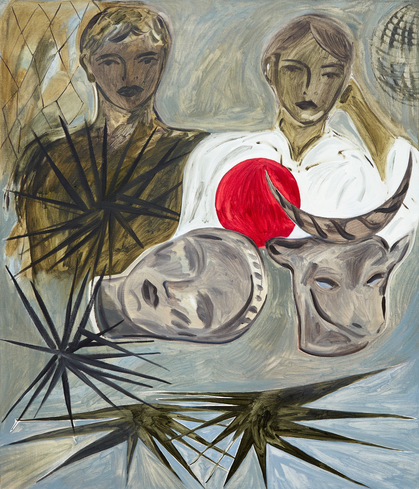-
From Current Issue
-
- Editor’s Letter Fire in the Heart
- Reviews I Gusti Ayu Kadek Murniasih
- Reviews 11th Seoul Mediacity Biennale: “One Escape at a Time”
- Dispatch Networked China
- One on One Monira Al Qadiri on Yukio Mishima
- Essays The rise of independent art spaces in pandemic-era Shanghai
- Features Tuan Andrew Nguyen
- Table of Contents
- Web Exclusives
- Archive
- Subscribe

R
E
V N
E
X
T
Installation view of FAYE WEI WEI’s Yes No, 2018, oil on canvas, 183 × 137 cm, at the Centre for Chinese Contemporary Art, Manchester, 2018. Photograph Joe Smith. Courtesy the Centre for Chinese Contemporary Art, Manchester.
The notion that gender is fluid and performed isn’t new. Simone de Beauvoir stated in 1949 that “one is not born, but rather becomes, a woman,” and it has been three decades since Judith Butler expanded on this, writing on the “unnaturalness” of gender. Yet, the boundaries of this unstable form of identification continue to shift and the plurality of its subject positions demand reappraisal, which explains the proliferation and relevance of exhibitions on gender today.
Presented as the latest exhibition of the “Concepts of Gender” series at Manchester’s Centre for Chinese Contemporary Art, Faye Wei Wei’s solo show featured four new oil paintings, made over the course of the past year. Two large canvases, Yes No (2017) and Good Bye (2017), each the height of the artist herself, flanked a medium-sized work, Bitter Water (2017). To the right of this group, on its own wall, was one painting barely larger than a sheet of paper, entitled From the Centre of the Rose (2017).
In each of the canvases are androgynous “boys” or “self portraits”—Wei Wei uses these terms interchangeably—that could be drawn from Greek or Roman statues, just as they could be young boys or girls from a Fauvist work. These figures are depicted with tenderness and care; silent, mouth closed, eyes wistfully gazing.
There is no immediacy, only indeterminacy, in Wei Wei’s work, which evokes a sense of surreal theatricality, comparable to Fra Angelico’s 15th-century frescoes at San Marco or Giorgio de Chirico’s warped, metaphysical paintings. They are difficult to classify; to restrict her paintings solely to the categories of still life or portraiture is to deny the multiple, often contradictory, components in the compositions.
Layered over and under the androgynous individuals are various motifs that allude to classical and modern sources: a garland of lilac flowers halo the figure in From the Centre of the Rose; while in Bitter Water, two people are shown behind a grey bull’s head, and a third face is tilted on its side—either a woman at rest or a toppled statue. To the right of this, the three characters in Good Bye each carry a bunch of flowers; a heavy curtain envelops the trio. The most enigmatic of the paintings is Yes No, to the far left of the group: in the top left of the canvas, an anonymous face is surrounded by a pale pink star, in the opposite corner a knight in a suit of armor with its visor down lies holding a blade. Painted on the very top layer of the work is a vivid blue merman; in the bottom corners are scallop shells.
The most significant of these motifs is the sea urchin—depicted in Bitter Water as a group of dark, painted lines—which appears across many of Wei Wei’s other works. The urchin holds a personal significance for the artist. Their soft, vivid-orange roe—their sexual organs—are her favorite food; a delicacy eaten raw after cracking open the spiny, sometimes venomous shell.
Talking to Wei Wei, painting is inseparable from the texture and sensuality of food. She compares brushing turpentine across a layer of fresh oil paint to cigarettes after a large meal—something to cut through the fat. Yellow flowers in Good Bye evoke drops of lemon juice; an individual brushstroke may be a fennel seed or a sprig of dill that lightens the heavy palette of browns, olive greens, pallid blues and grays. Each layer of the painting is a sensation on the tongue, an individual note of a palate. As with a recipe, flavors can be brought out only in combination, to be discerned and tasted before, during, and after an ingredient enters the mouth.
Wei Wei’s work parallels and reiterates this concept of gender that doesn’t assume a given state of things, a single point of origin, or the idea of naturalness, but which is suspended between shifting points of reference. The canvas is to be thought of not as a static image, but as a reactive surface or skin, which first needs to be primed and stretched, and which responds to the lightest touch;
to be sensed beyond that domain to which the medium of paint is conventionally restricted—her work doesn’t present a resistance
to interpretation or a closing down of meaning, but joy in its abundance.
Faye Wei Wei’s solo exhibition is on view at the Centre for Chinese Contemporary Art, Manchester, until July 8, 2018.
To read more of ArtAsiaPacific’s articles, visit our Digital Library.





